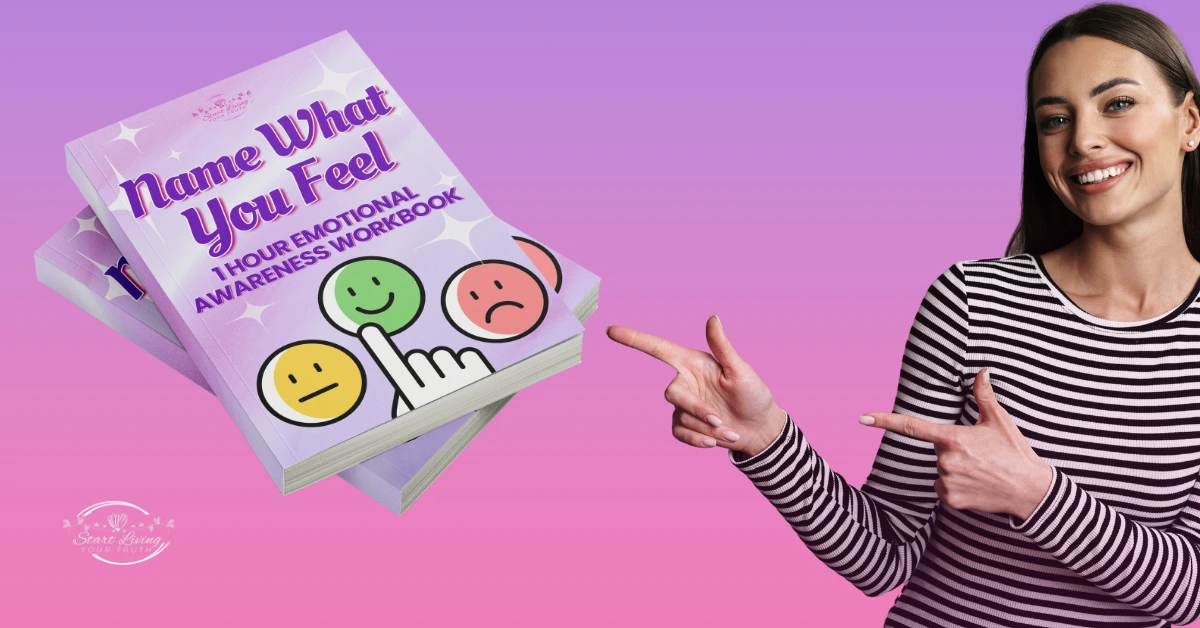

Let’s get one thing straight:
If you don’t know what you’re feeling, how the hell are you supposed to process it?
You can't set boundaries if you don’t even know why something feels off.
You can’t speak your truth if you haven’t figured out what that truth is.
And you definitely can’t create real connection—romantic, platonic, or otherwise—if you’re emotionally guessing your way or getting emotionally triggered through every interaction.

Most people walking around aren’t “fine.” They’re emotionally disconnected.
They’re snapping at their partner for no reason.
Ghosting friends.
Zoning out on their phone for hours because they feel “off,” but can’t put their finger on why.
If that’s been you? You’re not broken. You’re emotionally disoriented.
And no one ever taught you how to read the map.
Emotional awareness isn't some soft skill you work on after you’ve done the “real” healing.
It is the work.
Because if you can’t name what you’re feeling, you’ll keep misreading the signals.
You'll keep self-abandoning.
You’ll keep wondering why things feel hard, even when your life looks “okay” on the surface.

Here’s the part most people miss:
When you don’t know what you're feeling, your body and brain go into survival mode.
You start avoiding people, places, or situations—not because they’re unsafe, but because your nervous system feels unsafe and you can’t explain why.
So instead of saying “I’m feeling rejected,” you say “I’m just tired.”
Instead of saying “That crossed a boundary,” you say “I don’t want to make a big deal out of it.”
Instead of setting limits, you overextend and then resent everyone for it.
And what do you do after that?
Blame yourself.
Get stuck in a shame cycle.
Tell yourself you’re “too sensitive” or “too much.”
But the truth is—your emotions aren’t the problem.
Your disconnection from them is.
And the longer you ignore them, the louder they get.

Let’s talk about what this actually costs you:
When your emotions are all over the place and confusing, so is your thinking.
You overanalyze everything.
You replay conversations for hours.
You doubt every decision—even the small ones.
You start outsourcing your truth to everyone else.
“Does this sound crazy?”
“Am I overreacting?”
“Should I even bring this up?”
Your self-trust erodes every time you betray what you feel to protect how others might respond.
You attract people who benefit from your silence.
Or you become the fixer, the peacekeeper, the one who never needs anything—until you explode or disappear because you’re sick of being invisible.
Sound familiar?
This isn’t just about feelings.
It’s about your life.
When you don’t understand your emotions, everything suffers—your communication, your boundaries, your sense of self.And no, you don’t rise above that with mindset hacks or affirmations.
You rise by going deeper into your emotions to understand and name them.

Here’s where the shift begins.
When you stop avoiding your emotions and start naming them, everything starts to click.
No more wondering if you’re being “too much.”
You can feel the discomfort, name it, and ask: “Is this mine? Or is this old stuff showing up?”
You stop reacting. You start responding.
From your values. Your truth.
You don’t need to write a 3-paragraph disclaimer just to say no.
You don’t minimize your needs down to be “easier to love.”
You speak up—and stay grounded when you do.
That’s not just emotional intelligence. That’s self-respect.
When you can track a feeling back to its root, it loses power over you.
You stop shoving it down with food, alcohol, scrolling, or overwork.
You meet it. Move through it. And then move on.
That’s what emotional regulation actually looks like.
You become more compassionate—not just with others, but with yourself.
You recognize when someone’s emotional reaction isn’t yours to fix.
You stop walking on eggshells and start walking in truth.This doesn’t just feel better—it is better.

If you’ve been in therapy…
If you’ve journaled, meditated, self-reflected your way to exhaustion…
But still can’t figure out why you feel so emotionally “off”?
You’re not lazy.
You’re not “unhealed.”
You’ve just been using tools that assume you already know what you’re feeling.
But if no one ever helped you learn to recognize your own emotional patterns, how are you supposed to work with them?
You’re not broken.
You’re emotionally under-languaged.
And that’s why I created Name What You Feel – 1 Hour Emotional Awareness Workbook.
Not another mindset workbook.
Not a vague “feel your feelings” pep talk.
This is a practical, emotionally attuned guide for people who feel everything—but struggle to name anything.

Name What You Feel – 1 Hour Emotional Awareness Workbook isn’t about managing your emotions.
It’s about understanding them, so they stop managing you.
This isn’t fluffy. It’s foundational.
Because when you go deeper and learn to name it—you finally have the power to change it.

What if instead of going down a rabbit hole of emotional turmoil and feeling bad about yourself, you could pause and say:
“Oh. That’s sadness. Not weakness.”
“That’s fear. Not a sign to back out—just a sign to move slower.”
“That’s a boundary being crossed. Time to speak up.”
Can you imagine how much more grounded, clear, and connected you’d feel?
Can you imagine how different your relationships would be if you showed up from truth instead of confusion?
That’s what happens when you build emotional clarity.
Not overnight.
But one named feeling at a time.

If you're tired of feeling unsure, confused, reactive, or misunderstood…
If you’re done waiting for someone else to give you the words…
Then start here.
Name What You Feel – 1 Hour Emotional Awareness Workbook is your next step toward clarity, connection, and emotional leadership—from the inside out.
👉 Click here to get your copy now. Because you can’t heal what you can’t name.
But once you do? Everything starts to change.